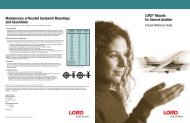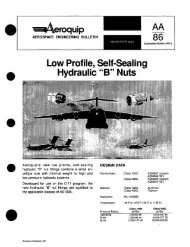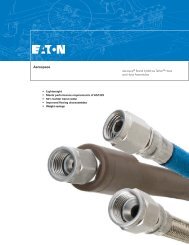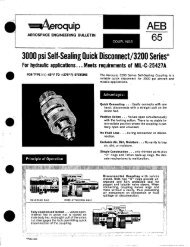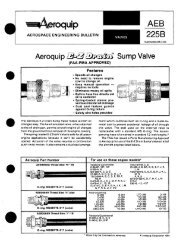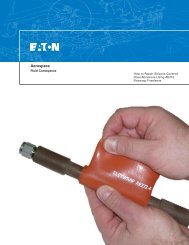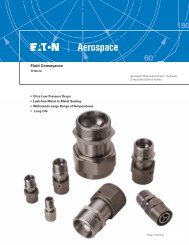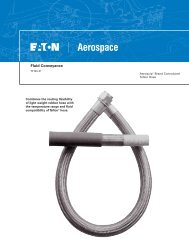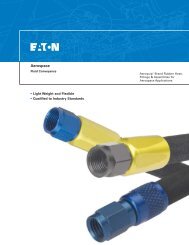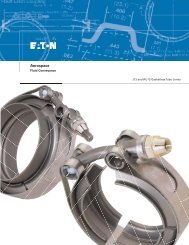Centurion Seal - Herber Aircraft
Centurion Seal - Herber Aircraft
Centurion Seal - Herber Aircraft
Create successful ePaper yourself
Turn your PDF publications into a flip-book with our unique Google optimized e-Paper software.
Mating Rings For Face-Type <strong>Seal</strong>s & Runners For Circumferential <strong>Seal</strong>s<br />
Face-Type <strong>Seal</strong>s for Large Engine Mainshafts<br />
<strong>Centurion</strong> Brand Mating<br />
Rings for Face-Type <strong>Seal</strong>s<br />
and Runners for<br />
Circumferential <strong>Seal</strong>s<br />
Mating Ring<br />
Good seal performance is provided<br />
by a properly configured<br />
stator (seal) mated to a high<br />
quality, tightly toleranced rotor<br />
(mating ring or runner). Therefore,<br />
Eaton’s <strong>Centurion</strong> brand<br />
seals should be accompanied<br />
by mating rings or rotors<br />
designed and fabricated by<br />
Eaton. Like the carbon-graphite<br />
seal face in our face seals,<br />
the associated mating ring<br />
must be extremely flat (typically<br />
2 to 3 Helium light bands<br />
or 0.000022 to 0.000033<br />
inches—0.6 to 0.9 mm) and<br />
possess a smooth finish (4 Ra<br />
- 0.1 micrometers).<br />
Mating rings must be retained<br />
on a shaft in a manner that<br />
prevents slippage, leakage,<br />
and distortion. It must also be<br />
properly aligned with sources<br />
of lubrication, and are often<br />
“balanced.” Likewise, circumferential<br />
seal rotors must be<br />
round, smooth and balanced.<br />
They can be optimized to<br />
minimize coning, and in<br />
some cases may require spin<br />
testing. Some rotors require<br />
hydrostatic or hydrodynamic<br />
geometry to either aid in lifting<br />
off or suctioning down its seal<br />
ring.<br />
Hydrodynamic Mating Ring<br />
Materials for rotors must have<br />
excellent thermal conductivity<br />
and surface hardness. In<br />
some cases coatings may be<br />
required. Understanding operating<br />
parameters for the seal<br />
and mating ring set will allow<br />
the designer to tailor a solution<br />
with the proper design, materials,<br />
and coatings.<br />
<strong>Centurion</strong> Brand Face-Type<br />
<strong>Seal</strong>s for Large Engine<br />
Mainshafts<br />
<strong>Centurion</strong> brand Face-Type <strong>Seal</strong> for<br />
Large Engine Mainshafts<br />
Face-type seals used on large<br />
engine mainshafts are similar<br />
in construction to conventional<br />
700 class seals, but have additional<br />
characteristics to handle<br />
the surface speeds, temperatures<br />
and pressures typically<br />
required of such applications.<br />
The carbon seal ring stator is<br />
housed into a metal carrier<br />
and is spring loaded against<br />
the mating ring (rotor) by a<br />
series of coil springs. Due<br />
to the temperature requirements,<br />
elastomers are not<br />
used. Instead, the secondary<br />
seal is one or two piston rings<br />
comprised of metal, carbon<br />
graphite, or a Teflon ® jacketed<br />
spring seal. Such large<br />
diameter face seals are usually<br />
required to seal high temperature<br />
air. At high speeds<br />
and pressures, some seals<br />
are configured to introduce oil<br />
lubrication directly at the interface,<br />
and are achieved by a<br />
flow of oil introduced through<br />
the mating ring. The oil dissipates<br />
heat and introduces<br />
lubrication at the interface.<br />
These seals are referred to as<br />
Face-Type <strong>Seal</strong>s for Engine<br />
Mainshafts Performance<br />
Size (English)<br />
Size (Metric)<br />
Speed (English)<br />
Speed (Metric)<br />
Pressure (English)<br />
Pressure (Metric)<br />
Temperature (English)<br />
Temperature (Metric)<br />
Leakage (English)<br />
Leakage (Metric)<br />
Life<br />
Comments<br />
a “wet” face configuration.<br />
Eaton’s <strong>Centurion</strong> brand facetype<br />
seals are used to protect<br />
bearing sumps from hot gases<br />
at elevated pressure when<br />
conventional buffered labyrinth<br />
seals either take up too<br />
much axial and radial space in<br />
the design of the gas turbine<br />
mainshaft, are too heavy, or<br />
are insufficient to manage the<br />
required controlled leakage.<br />
4” to 20”<br />
100 to 500 mm<br />
400 feet /<br />
second<br />
120 m/s<br />
150 PSID<br />
10 bar<br />
800°F<br />
425°C<br />



